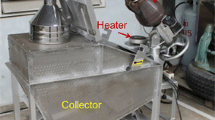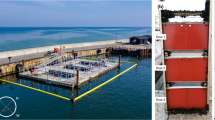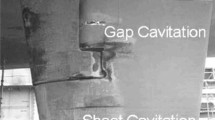Abstract
The aim of this research was to establish whether the shell of green-lipped mussels and Pacific oysters could be plasma sprayed to promote and accelerate the establishment of filter feeder colonies. While CaCO3 degrades before melting under equilibrium conditions, the hypothesis considered in this work was that the high-temperature, highly nonequilibrium conditions experienced by powders during plasma spraying may be sufficient to impart enough thermal energy into the powder, at a fast enough rate, that the CaCO3 phase would melt before undergoing total thermal degradation. Sprayable mussel and oyster shell powder was manufactured by crushing and milling. A range of plasma spray parameters incorporating a wide operating window of plasma power and gas velocity were trialed. Coatings were initially formed from both powders under all plasma spray conditions used. However, the samples degraded into powdery debris with time due to the reaction of CaO with water in the air to form Ca(OH)2. No evidence of CaCO3 melting was found, indicating that it was not possible to form a coating by thermal spraying. The mechanism of inflight particle phase degradation is presented for both powders, along with proposed mechanism of initial coating formation due to melting of CaO.






















Similar content being viewed by others
References
J. Kobak, Factors Influencing the Attachment Strength of Dreissena Polymorpha (Bivalvia), Biofouling, 2006, 22(3), p 153-162
A. Pivac, Utility of bivalve aquaculture of urban environments in New Zealand (Masters Thesis), The University of Auckland, 2016
M.K. La Peyre, K. Serra, T.A. Joyner, and A. Humphries, Assessing Shoreline Exposure and Oyster Habitat Suitability Maximizes Potential Success for Sustainable Shoreline Protection Using Restored Oyster Reefs, PeerJ, 2015, 2015(10), p e1317
E.M.A. Strain, C. Olabarria, M. Mayer-Pinto, V. Cumbo, R.L. Morris, A.B. Bugnot, K.A. Dafforn, E. Heery, L.B. Firth, P.R. Brooks, and M.J. Bishop, Eco-Engineering Urban Infrastructure for Marine and Coastal Biodiversity: Which Interventions Have the Greatest Ecological Benefit?, J. Appl. Ecol., 2018, 55(1), p 426-441
D. Parsons, Green-Lipped Mussels and the Hauraki Gulf, Retrieved from: http://temp.aucklandcouncil.govt.nz/EN/AboutCouncil/representativesbodies/haurakigulfforum/Documents/GreenlippedmusselsandtheHaurakiGulfDarrenParsons.pdf.
S.C. Fitzer, L. Vittert, A. Bowman, N.A. Kamenos, V.R. Phoenix, and M. Cusack, Ocean Acidification and Temperature Increase Impact Mussel Shell Shape and Thickness: Problematic for Protection?, Ecol. Evol., 2015, 5(21), p 4875-4884
A.G. Jeffs, R.C. Holland, S.H. Hooker, and B.J. Hayden, Overview and Bibliography of Research on the Greenshell Mussel, Perna Canaliculus, from New Zealand Waters, J. Shellfish Res., 1999, 18(2), p 347-360
H. de Paoli, J. van de Koppel, E. van der Zee, A. Kangeri, J. van Belzen, S. Holthuijsen, A. van den Berg, P. Herman, H. Olff, and T. van der Heide, Processes Limiting Mussel Bed Restoration in the Wadden-Sea, J. Sea Res., 2015, 103, p 42-49
M. Wilcox and A. Jeffs, Is Attachment Substrate a Prerequisite for Mussels to Establish on Soft-Sediment Substrate?, J. Exp. Mar. Biol. Ecol., 2017, 495, p 83-88
N. Aldred, L.K. Ista, M.E. Callow, J.A. Callow, G.P. Lopez, and A.S. Clare, Mussel (Mytilus edulis) Byssus Deposition in Response to Variations In Surface Wettability, J. R. Soc. Interface, 2006, 3(6), p 37-43
J.R. Almeida and V. Vasconcelos, Natural Antifouling Compounds: Effectiveness in Preventing Invertebrate Settlement and Adhesion, Biotechnol. Adv., 2015, 33(3-4), p 343-357
A.S. Clare, N. Aldred, Surface colonisation by marine organisms and its impact on antifouling research, in Advances in Marine Antifouling Coatings and Technologiesed, 2009, pp. 46-79
S. Dobretsov, R.M.M. Abed, and C.R. Voolstra, The Effect of Surface Colour on the Formation of Marine Micro and Macrofouling Communities, Biofouling, 2013, 29(6), p 617-627
E.R. Holm, G. Cannon, D. Roberts, A.R. Schmidt, J.P. Sutherland, and D. Rittschof, The Influence of Initial Surface Chemistry on Development of the Fouling Community at Beaufort, North Carolina, J. Exp. Mar. Biol. Ecol., 1997, 215(2), p 189-203
M. Lejars, A. Margaillan, and C. Bressy, Fouling Release Coatings: A Nontoxic Alternative to Biocidal Antifouling Coatings, Chem. Rev., 2012, 112(8), p 4347-4390
A.G. Nurioglu, A.C.C. Esteves, and G. De With, Non-Toxic, Non-Biocide-Release Antifouling Coatings Based on Molecular Structure Design for Marine Applications, J. Mater. Chem. B, 2015, 3(32), p 6547-6570
L. Petrone, Molecular Surface Chemistry in Marine Bioadhesion, Adv. Colloid Interface. Sci., 2013, 195-196, p 1-18
A.J. Scardino, Surface modification approaches to control marine biofouling, in Advances in Marine Antifouling Coatings and Technologiesed, 2009, pp. 664-692
A.W. Decho and T. Gutierrez, Microbial Extracellular Polymeric Substances (Epss) in Ocean Systems, Front. Microbiol., 2017, 8(MAY), p 922
A.M. Ganesan, The role of bacterial biofilms on the settlement and nutrition of mussel (Perna canaliculus) larvae and juveniles, Auckland University of Technology, 2012
M.G. Hadfield, Biofilms and Marine Invertebrate Larvae: What Bacteria Produce That Larvae Use to Choose Settlement Sites, Ann. Rev. Marine Sci., 2011, 3, p 453-470
J.L. Yang, Y.F. Li, X. Liang, X.P. Guo, D.W. Ding, D. Zhang, S. Zhou, W.Y. Bao, N. Bellou, and S. Dobretsov, Silver Nanoparticles Impact Biofilm Communities and Mussel Settlement, Sci. Rep., 2016, 6, p 37406
X. Yu, W. He, H. Li, Y. Yan, and C. Lin, Larval Settlement and Metamorphosis of the Pearl Oyster Pinctada Fucata in Response to Biofilms, Aquaculture, 2010, 306(1–4), p 334-337
C.S. Choi and Y.W. Kim, A Study of the Correlation Between Organic Matrices and Nanocomposite Materials in Oyster Shell Formation, Biomaterials, 2000, 21(3), p 213-222
Y. Dauphin, A.D. Ball, H. Castillo-Michel, C. Chevallard, J.P. Cuif, B. Farre, S. Pouvreau, and M. Salomé, In Situ Distribution and Characterization of the Organic Content of the Oyster Shell Crassostrea gigas (Mollusca, Bivalvia), Micron, 2013, 44(1), p 373-383
S. Hahn, R. Rodolfo-Metalpa, E. Griesshaber, W.W. Schmahl, D. Buhl, J.M. Hall-Spencer, C. Baggini, K.T. Fehr, and A. Immenhauser, Marine Bivalve Shell Geochemistry and Ultrastructure from Modern Low pH Environments: Environmental Effect Versus Experimental Bias, Biogeosciences, 2012, 9(5), p 1897-1914
S.W. Lee, Y.N. Jang, K.W. Ryu, S.C. Chae, Y.H. Lee, and C.W. Jeon, Mechanical Characteristics and Morphological Effect of Complex Crossed Structure in Biomaterials: Fracture Mechanics and Microstructure of Chalky Layer in Oyster Shell, Micron, 2011, 42(1), p 60-70
H.M. Leung and S.K. Sinha, Scratch and Indentation Tests on Seashells, Tribol. Int., 2009, 42(1), p 40-49
C. Martínez-García, B. González-Fonteboa, F. Martínez-Abella, and D. Carro- López, Performance of Mussel Shell as Aggregate in Plain Concrete, Constr. Build. Mater., 2017, 139, p 570-583
S.S. Xie, O. Vasylkiv, and A.I.Y. Tok, Highly Ordered Nano-Scale Structure in Nacre of Green-Lipped Mussel Perna Canaliculus, CrystEngComm, 2016, 18(39), p 7501-7505
G.L. Yoon, B.T. Kim, B.O. Kim, and S.H. Han, Chemical-Mechanical Characteristics of Crushed Oyster-Shell, Waste Manag, 2003, 23(9), p 825-834
D. Lide (ed.), CRC Handbook of Chemistry and Physics (86 edn), (CRC Press, 2005)
S.M. Antao, The Crystal Structure of a Biogenic Aragonite from the Nacre of an Ammonite Shell, RSC Adv., 2012, 2(2), p 526-530
J.C. Kim, S.W. Lee, and Y.N. Jang, Characteristics of the Aragonitic Layer in Adult Oyster Shells, crassostrea gigas: Structural Study of Myostracum Including the Adductor Muscle Scar, Evid Based Complement. Altern. Med., 2011, 2011, p 742963
M. Ni and B.D. Ratner, Differentiating Calcium Carbonate Polymorphs by Surface Analysis Techniques—An XPS and TOF-SIMS Study, Surf. Interface Anal., 2008, 40(10), p 1356-1361
S.P. Thompson, J.E. Parker, and C.C. Tang, Thermal Breakdown of Calcium Carbonate and Constraints on its use as a Biomarker, Icarus, 2014, 229, p 1-10
E.N. Caspi, B. Pokroy, P.L. Lee, J.P. Quintana, and E. Zolotoyabko, On the Structure of Aragonite, Acta Crystallogr. B, 2005, 61(2), p 129-132
W. Yang, N. Kashani, X.W. Li, G.P. Zhang, and M.A. Meyers, Structural Characterization and Mechanical Behavior of a Bivalve Shell (Saxidomus purpuratus), Mater. Sci. Eng. C, 2011, 31(4), p 724-729
J. Sun and B. Bhushan, Hierarchical Structure and Mechanical Properties of Nacre: A Review, RSC Adv., 2012, 2(20), p 7617-7632
M.R. Mucalo, D.L. Foster, B. Wielage, S. Steinhaeuser, H. Mucha, D. Knighton, and J. Kirby, The Novel Use of Waste Animal Bone from New Zealand Agricultural Sources as a Feedstock for Forming Plasma Sprayed Hydroxyapatite Coatings on Biomedical Implant Materials, J. Appl. Biomater. Biomech., 2004, 2, p 96-104
L. Lutterotti, Total Pattern Fitting for the Combined Size-Stress-Texture Determination in Thin Film Diffraction, Nucl. Inst. Methods Phys. Res. B, 2010, 268, p 334-340
L. Lutterotti, R. Ceccato, R. Dal Maschio, E. Pagani, Quantitative analysis of silicate glass in ceramic materials by the Rietveld method, in Materials Science Forumed, 1998, pp. 87-92
L. Génio, S. Kiel, M.R. Cunha, J. Grahame, and C.T.S. Little, Shell Microstructures of Mussels (Bivalvia: Mytilidae: Bathymodiolinae) from Deep-Sea Chemosynthetic Sites: Do They Have a Phylogenetic Significance?, Deep-Sea Res. Part I: Oceanograph. Res. Pap., 2012, 64, p 86-103
M. Felipe-Sesé, D. Eliche-Quesada, and F.A. Corpas-Iglesias, The Use of Solid Residues Derived from Different Industrial Activities to Obtain Calcium Silicates for Use as Insulating Construction Materials, Ceram. Int., 2011, 37(8), p 3019-3028
G.T. Faust, Thermal Analysis Studies on Carbonates I. Aragonite and Calcite, Am. Mineral., 1950, 35(3-4), p 207-224
S. Yoshioka and Y. Kitano, Transformation of Aragonite to Calcite Through Heating, Geochem. J., 1985, 19(4), p 245-249
F. Hamer and J Hamer, The Potter’s Dictionary of Materials and Techniques, 5th ed., University of Pennsylvania Press, Philadelphia, 2004, p 47. https://books.google.co.nz/books?id=TApnGTVLwxAC&printsec=frontcover&source=gbs_ge_summary_r&cad=0#v=onepage&q&f=false
G.H. Aylward and T.J.V. Findlay, SI, Chemical Data, 2nd ed., Wiley, New York, 1971
Acknowledgments
The authors gratefully acknowledge the support of North Island Mussels Ltd (Tauranga, New Zealand) in supplying the mussel shells used in this work. The assistance of Holster Engineering (Tokoroa, New Zealand) in performing the plasma spray trials is also sincerely appreciated.
Author information
Authors and Affiliations
Corresponding author
Additional information
Publisher's Note
Springer Nature remains neutral with regard to jurisdictional claims in published maps and institutional affiliations.
Rights and permissions
About this article
Cite this article
Matthews, S., Asadov, A. Plasma Spraying of CaCO3 Coatings from Oyster and Mussel Shell. J Therm Spray Tech 29, 1144–1171 (2020). https://doi.org/10.1007/s11666-020-01024-7
Received:
Revised:
Published:
Issue Date:
DOI: https://doi.org/10.1007/s11666-020-01024-7




